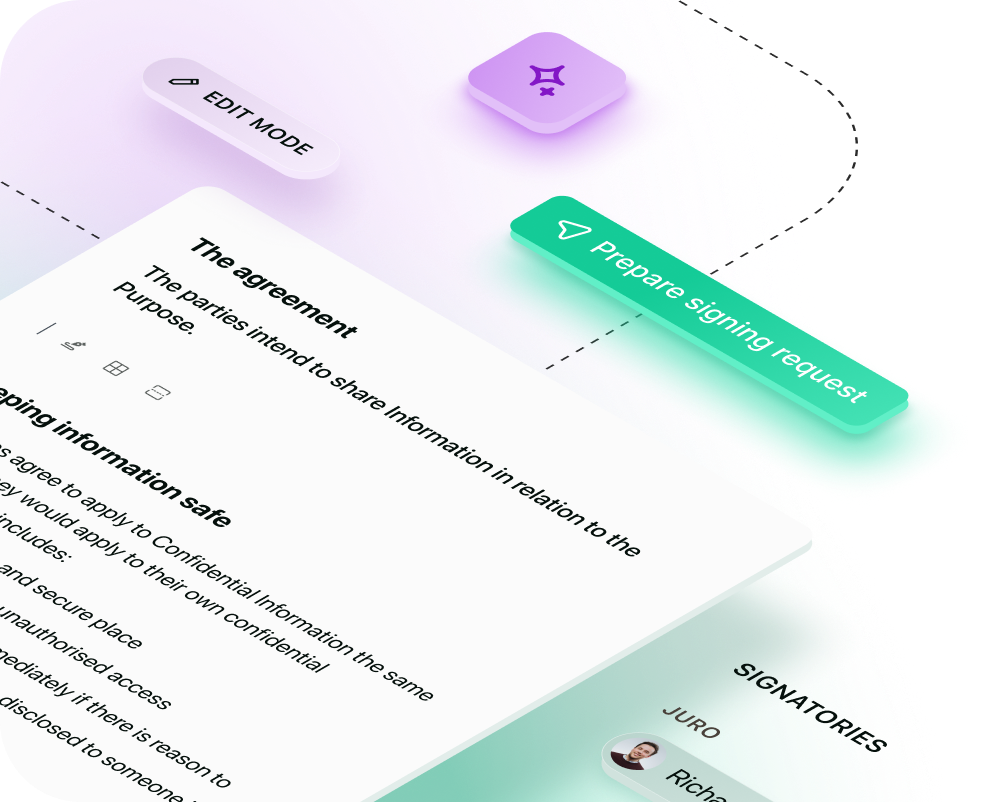Solutions
Customer Support
Resources
This employee equipment agreement template helps formalize terms for the use of company-owned tools or devices with ease.




Managing company equipment can be a hassle – especially as your business scales. Employees need the right tools to do their jobs effectively, but providing them brings its own set of challenges. This is where an employee equipment agreement comes in.
An employee equipment agreement makes sure that everyone understands the responsibilities and conditions associated with company equipment.
This article will explore the key aspects of employee equipment agreements, the benefits of using templates, and how to manage these agreements effectively.
An employee equipment agreement is a document that outlines the terms and conditions under which an employer provides equipment to an employee. This may include laptops, mobile phones, software and other tools necessary for the employee to perform their role.
The agreement specifies the responsibilities of both parties regarding the use, maintenance and return of the equipment. It also addresses issues such as liability for loss or damage and the protocols for reporting problems.
An employee equipment agreement serves several key purposes:
Overall, an employee equipment agreement helps maintain the integrity of company assets, sets clear expectations, and protects both the company and its employees from potential issues related to equipment use and management.

Effective management of employee equipment agreement contracts usually involves collaboration between multiple departments, who together ensure all aspects of the process are handled efficiently and in accordance with company policies.
Human Resources often oversees the administration of these agreements, ensuring that they are signed during the onboarding process and updated as necessary. They keep records of all equipment issued to employees and track the return of equipment when an employee leaves the company.
For technology-related equipment, the IT department may handle the issuance, maintenance and tracking of devices such as laptops, smartphones and other tech tools. They make sure that the equipment meets company standards and is properly configured for the employee's role.
In companies where non-technical equipment (like furniture or other office supplies) is issued, office management or facilities may manage these agreements. They handle the logistics of distributing and maintaining these items.
The legal department may be involved in drafting and reviewing the terms of the agreements to ensure they comply with relevant laws and adequately protect the company's interests. They might also handle disputes or issues that arise related to the agreements.
Individual department managers may also play a role in managing equipment agreements for their team members. They ensure employees understand their responsibilities and follow up on the return of equipment when necessary.
Employee equipment agreement templates can be used in various scenarios, such as:
A comprehensive employee equipment agreement template should cover several key elements:
Introduction. A brief introduction explaining the purpose of the agreement.
Equipment list. A detailed list of the equipment being provided, including serial numbers and descriptions.
Use of equipment. Guidelines on how the equipment should be used, including any restrictions on personal use.
Maintenance and repair. Responsibilities for maintaining the equipment and reporting any issues.
Liability. Terms outlining who is responsible for the equipment in case of loss, damage or theft.
Data privacy and security. Requirements for protecting company data stored on the equipment.
Return procedures. Instructions for returning the equipment when no longer needed or upon termination of employment.
Governing law. The legal jurisdiction governing the agreement.
Acknowledgment. A section for the employee to sign, acknowledging they have read and understood the terms.

Employee equipment agreement templates are usually managed through a structured process involving several key steps:
Templates are created by HR, legal or IT departments, ensuring they comply with company policies and legal requirements. They are reviewed regularly and updated as needed.
Templates are stored in a central repository – like a document management system or an internal shared drive – where they can be easily accessed by relevant personnel.
When an employee is issued equipment, the relevant department (HR, IT or office management) provides the template to the employee for completion. This can be done electronically or on paper.
Completed agreements are reviewed by a supervisor or department manager to ensure all necessary information is included and accurate. They then approve and sign the document.
Signed agreements are filed in the employee’s personnel file or a dedicated equipment tracking system. This ensures a record is kept for reference in case of disputes or when equipment is returned.
Departments responsible for equipment management regularly monitor the status of issued equipment and update records as needed. They make sure that agreements are in place for all issued equipment and follow up missing or outdated agreements.
When equipment is returned, the responsible department checks the condition against the agreement and updates the records. Any discrepancies or issues are addressed according to the terms of the agreement.
Periodic audits are conducted to ensure compliance with the equipment agreement policies. This helps identify any gaps or issues in the process and ensures proper management of company assets.
While using templates simplifies the process, there are still challenges:
Juro can be used to automate employee equipment agreements by leveraging its AI-native contract management platform to streamline the entire lifecycle of these agreements.

Here’s how:
By leveraging Juro’s capabilities, companies can automate and streamline the management of employee equipment agreements – reducing administrative overhead, ensuring compliance and improving the overall efficiency of the process.
Juro’s AI-native contract automation platform empowers all teams to create, agree, execute and manage contracts up to 10x faster than traditional tools. To find out more, hit the button below to book your personalized demo.
Juro is the #1-rated contract platform globally for speed of implementation.


Juro embeds contracting in the tools business teams use every day, so they can agree and manage contracts end-to-end - while legal stays in control.
Book your demo